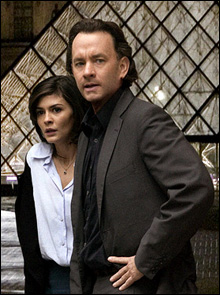
NOT EXACTLY HEPBURN AND GRANT: Audrey Tautou and Tom Hanks
|
That Dan Brown’s The Da Vinci Code has become a worldwide phenomenon attests to the worldwide yearning for a better truth than the one we have. Even for pulp, the book is poorly written. Its “facts” are all fiction; its “puzzles,” particularly the one about the Pope, the knight, and the missing orb, are simple enough to be solved by anybody (or maybe that’s the point); its protagonist, the Harvard professor of a non-existent discipline, is insufferable with his incessant “Most people don’t know that . . . ” Accommodating just two female characters, the Sex Object and the Wise Grandma, it hardly lives up to its own ideal of the “sacred feminine,” and Brown somehow forgot to tell us that the Mona Lisa is really Mary Magdalene. Yet The Da Vinci Code has sold 50 million copies. Inevitably, the movie. After all, Professor Brown, er, Langdon is described as “Harrison Ford in tweed.” No Harrison in this film, however. It can’t have been his age (63) — Hollywood men are never too old for a part. (Hollywood’s sacred females are another matter.) Instead we get rugged, professorial Tom Hanks as Langdon and cryptologist look-alike Audrey Tautou as Sophie Neveu, not exactly the Cary Grant and Audrey Hepburn who lit up another mystery set in the City of Light, the 1963 film Charade. And Ron Howard, despite his Oscar for A Beautiful Mind, hasn’t appeared on many Greatest Filmmaker lists. Yes, a movie Da Vinci Code that ditched the sophomoric sermonizing to focus on plot and character could go farther than just the nearest Swiss bank. But how do you make a thriller thrilling when everyone knows the story? Or puzzles puzzling when everybody’s solved them?
The solution isn’t anywhere near Isaac Newton’s tomb — it would have to be in the way Langdon and Sophie re-create the love that Brown posits between Jesus and Mary Magdalene. And they don’t. Hanks’s long hair and dissipated physique mark him as a Harvard hipster; the only lines he delivers with any spontaneity and conviction are the ones that don’t come out of the book (like the “balloon animals” remark when he initiates Sophie into the symbols for male and female), and he orbits around Tautou as if Langdon knew all along that Sophie is the last living descendant of Jesus. Or maybe Howard has gone PC on us by deciding that a 49-year-old man shouldn’t be sparking a 29-year-old woman. Serious about her role and a little stiff in it, Tautou throws the odd winning glance Hanks’s way, but he’s too busy tracking down the Eternal Feminine to notice that it’s right in front of him.
What’s left is 454 pages crammed into 149 minutes — which means the plot is even more confusing. Howard has wisely reduced the two cryptexes to one; Bézu Fache has an affiliation that’s not mentioned in the book, there are changes in the character of Vernet and the relationship of Opus Dei and the Vatican, and Sophie throws in some 007-like pyrotechnics behind the wheel of her SmartCar. The movie also attempts to placate Christians by having Langdon challenge Leigh Teabing’s more ridiculous notions, but Howard and Hanks make a wimpy job of it, particularly since we’ve just seen lurid flashbacks of Templars and witches being burned by the Church that would make Cecil B. DeMille blush. Ian McKellen overplays and undercuts Sir Leigh, enjoying himself while Hanks and Tautou stand around looking glum; it makes you wonder what Bill Murray — with a different director — might have done as Langdon. (Or Ethan Hawke with Julie Delpy . . . ) Paul Bettany’s Silas and Alfred Molina’s Aringarosa go the caricature route, having no scope to do anything else; Jean Reno hints at a more complex Bézu Fache. Hans Zimmer’s score is by turns suspense-lite, romantic-lite, devotional-lite.
Hanks finds himself at the very end, when he kneels before the Louvre’s Inverse Pyramid and Brown’s clever concluding conceit is revealed, but if The Da Vinci Code had any truth in it, Langdon would have knelt before Sophie. Bogus book, bogus movie.